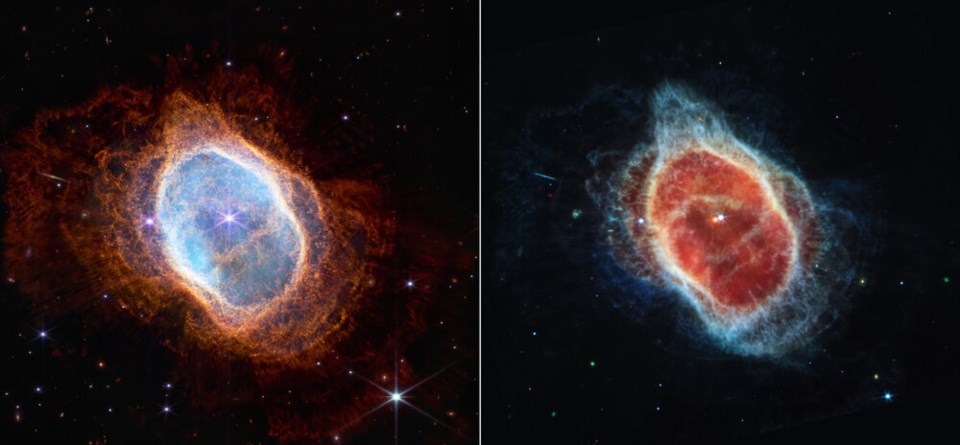‚ÄãAstronomers have found the first “two-faced” star — a spinning orb half covered in super-heated helium, half capped in hydrogen — in a discovery that offers a new window on cosmic evolution.
The white dwarf, nicknamed Janus after the Roman god of transition, lies roughly 1,200 light years from Earth. It was first discovered in a wide-angle scan of the sky by Caltech’s Palomar Observatory near San Diego.
Ilaria Caiazzo, a postdoctoral scholar at Caltech and a former University of British Columbia PhD student, then focused in on the highly magnetized white dwarf using Caltech’s CHIMERA (HIgh-speed Multi-color camERA) and the Gran Telescopio Canarias in Spain’s Canary Islands — the world’s largest mirrored telescope tracking visible light.
Where the first pass offered a snapshot of a blinking star, the more focused telescopes shot a kind of movie of the white dwarf with a very high frame rate.
“When I show the observations to people, they are blown away,” said Caiazzo in a statement.
The , published Wednesday in the journal , involved 37 researchers from seven countries.
Co-author Jeremy Heyl, a U–°¿∂ ”∆µ professor of astronomy and Caiazzo’s former supervisor, described the star as “a pretty special object.”
“This is the first of the two-faced stars,” Heyl said. “We've kind of caught it right in the middle of this transition.”
Imagine seeing the Earth for the first time when only the Pacific Ocean is in view. You might think the planet was made of water. But 12 hours later, if you didn't know any better, the planet would turn and a rush of continents would come into view.
Now picture Janus, a star the mass of the sun compressed into the size of Earth, spinning so fast it takes only 15 minutes to make a full rotation.
“There's a part of the time where you only see hydrogen, and there's part of the time when you only see helium, Heyl said.
“They've managed to completely sort themselves out.”
White dwarf a common cosmic end game
Big stars, those more than 10 times the size of Earth's sun, tend to supernova at the end of their lives. Anything smaller than that awaits a dense future as a white dwarf.
Sometimes known as ‘zombie stars,’ these form after a star has puffed out into a red giant, only to have its outer fuel blown away. After 10 billion years of nuclear burning, what’s left are the dense ashes of something that once could have looked strikingly similar to our sun.
Under the right circumstances, shedding the envelope off the star will make something called a planetary nebula, offering astronomers spectacular images of a star’s final “performance,” as NASA put it last year when it released some of the first images captured with the new and powerful James Webb Telescope.
Janus, however, is not the Milky Way’s typical white dwarf. Heyl says its relatively large mass suggests it may have formed through the merging of two orbiting white dwarfs.‚Äã

Young white dwarfs tend to pull heavy elements into their centre, leaving hydrogen, the lightest element, at the surface. As they age, a white dwarf cools, a process that is thought to allow for more mixing. But past observations have tended to show stars dominated by either helium or hydrogen. Janus's two distinct gaseous faces are thought to offer a glimpse of the star caught in the middle of a transformation.
The researchers suspect a powerful but unbalanced magnetic field has allowed the white dwarf to develop into two hemispheres. On one side, a weaker magnetic field allows the super-heated core of the star to send the heavier gas bubbling to the surface, forming an ocean of helium. On the other side, a stronger magnetic field allows the hydrogen to act as a lid, suppressing the heavier gas deeper in the star, Heyl and his colleagues suspect.
“It’s pretty striking,” said the U–°¿∂ ”∆µ astronomer. “We're catching a rather rare white dwarf, a massive white dwarf, who's rotating fast, but also at a rare time in its life cycle.”
“You'd have to look through hundreds of thousands of white dwarfs to find this particular Janus.”
A celestial Superman moment
Theoretically, our sun will become a white dwarf six billion years from now. But when astronomers look out into the universe, they don’t often see things changing at the time-scale stars need to live and die. Instead, they capture moments shaded in ancient visible light or radio waves.
If they are lucky, astronomers might stumble across a kind of celestial Rosetta Stone — the ancient tablet inscribed with the same passage in Greek and Egyptian that helped archeologists decipher hieroglyphic writing.
“It’s like watching a movie, except we don't see the movie in order,” Heyl said. “We just see every single frame of the movie thrown out on the floor. And we have to rearrange it into what the movie actually looks like.”
What Janus offers, added Heyl, is a key inflection point of a growing cosmic narrative. If it were a movie, it would be like finally catching the scene where Superman swaps the suit and glasses of a reporter for the tights and a cape of a superhero, the –°¿∂ ”∆µ researcher said.
“This star is changing its identity,” he said. “That's pretty amazing.”



